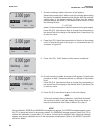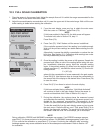
MODEL 54eA SECTION 12.0
CALIBRATION - pH
SECTION 12.0
CALIBRATION - pH
12.1 INTRODUCTION
A new pH sensor must be calibrated before use. Regular recalibration is also necessary.
A pH measurement cell (pH sensor and the solution to be measured) can be pictured as a battery with an extreme-
ly high internal resistance. The voltage of the battery depends on the pH of the solution. The pH meter, which is
basically a voltmeter with a very high input impedance, measures the cell voltage and calculates pH using a con-
version factor. The actual value of the voltage-to-pH conversion factor depends on the sensitivity of the pH sens-
ing element (and the temperature). The sensing element is a thin, glass membrane at the end of the sensor. As
the glass membrane ages, the sensitivity drops. Regular recalibration corrects for the loss of sensitivity. pH cali-
bration standards, also called buffers, are readily available.
Two-point calibration is standard. Both automatic calibration and manual calibration are available. Auto calibration
avoids common pitfalls and reduces errors. Its use is recommended.
In automatic calibration the controller recognizes the buffer and uses temperature-corrected pH values in the cal-
ibration. The table below lists the standard buffers the controller recognizes. The controller also recognizes sever-
al technical buffers: Merck, Ingold, and DIN 19267. Temperature-pH data stored in the controller are valid between
at least 0 and 60°C.
pH at 25°C Standard(s)
(nominal pH)
1.68 NIST, DIN 19266, JSI 8802, BSI (see note 1)
3.56 NIST, BSI
3.78 NIST
4.01 NIST, DIN 19266, JSI 8802, BSI
6.86 NIST, DIN 19266, JSI 8802, BSI
7.00 (see note 2)
7.41 NIST
9.18 NIST, DIN 19266, JSI 8802, BSI
10.01 NIST, JSI 8802, BSI
12.45 NIST, DIN 19266
FIGURE 12-1. Calibration Slope and Offset
Note 1: NIST is National Institute of Standards,
DIN is Deutsche Institute für Normung, JSI is
Japan Standards Institute, and BSI is British
Standards Institute.
Note 2: pH 7 buffer is not a standard buffer. It is
a popular commercial buffer in the United
States.
During automatic calibration, the controller also measures
noise and drift and does not accept calibration data until
readings are stable. Calibration data will be accepted as soon
as the pH reading is constant to within the factory-set limits of
0.02 pH units for 10 seconds. The stability settings can be
changed. See Section 5.11.
In manual calibration, the controller still monitors readings for
stability; however, the buffer pH lookup feature is missing.
The user has to enter the correct pH at the temperature the
buffer is being used.
Once the controller completes the calibration, it calculates
the calibration slope and offset. The slope is reported as the
slope at 25°C. Figure 12-1 defines the terms.
The controller can also be standardized. Standardization is
the process of forcing the controller reading to match the
reading from a second pH instrument. Standardization is
sometimes called a one-point calibration.
71


















